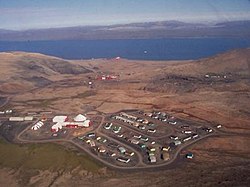Nanisivik
| Nanisivik | |
|---|---|
| Company town | |

Aerial view of Nanisivik
|
|
| Coordinates: 73°02′05″N 84°32′13″W / 73.03472°N 84.53694°W | |
| Country | Canada |
| Territory | Nunavut |
| Region | Qikiqtaaluk |
| Highest elevation | 341 m (1,119 ft) |
| Lowest elevation | 0 m (0 ft) |
| Population (2016) | |
| • Total | 0 |
| Time zone | EST (UTC-5) |
| • Summer (DST) | EDT (UTC-4) |
| Postal Code | X0A 0X0 |
| Area code(s) | 867 |
| Telephone Exchange | 436 |
| GNBC Code | OALHI |
| NTS Map | 048C01 |
Nanisivik (Inuktitut syllabics: ᓇᓂᓯᕕᒃ, translation for the place where people find things) was a company town which was built in 1975 to support the lead-zinc mining and mineral processing operations for the Nanisivik Mine, in production between 1976 and 2002. The townsite was located just inland from Strathcona Sound, about 20 km (12 mi) east of the community of Arctic Bay in the Canadian territory of Nunavut.
There is a port and dock about 3.7 km (2.3 mi) north of the former mine site which was used for shipping concentrate from the site, and receiving supplies (73°04′08″N 084°32′57″W / 73.06889°N 84.54917°W). It is currently used by the Canadian Coast Guard for training.
Nanisivik Airport located 8 NM (15 km; 9.2 mi) south was used as the main airport for Arctic Bay until 2010 when the lengthened Arctic Bay Airport took over. The airport is about 19 km (12 mi) directly southeast of Arctic Bay but the road between them is 32 km (20 mi).
The ore deposit resides within dolostone from the Society Cliffs Formation covered with dolomite shale from the Victor Bay Formation, which together form the Uluksan Group and reside on top of silty shale. The ore is believed to have formed when hot saline water bearing the metal ions of sodium, calcium, chlorine, and sulfate mixed with cooler carbonate-rich brine in the presence of natural gas or methane, which produced hydrogen sulfide through reducing the sulfate. The hydrogen sulfide then reacted with the metals to form the sulfides of marcasite (FeS2), pyrite (FeS2), sphalerite ((Zn,Fe)S), and galena (PbS). The Nanisivik deposit once contained 60 million metric tons of pyrite and 12 million tons of Lead-Zinc ore.
...
Wikipedia

